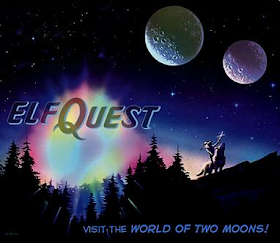How do we remember the times that are so far in the distant past that they are not only beyond history, but beyond memory? The ocean of time that earlier humanoid species and humans crossed before they even reached the outer boundaries of history is enormous: the Stone Age lasted 2.5 million years. Archaeological and geological research is almost our only means of telling what transpired in that period. Occasionally, these disciplines draw from astronomical findings, as with the report just out that the Earth may once have had two moons.
Myths and epics of deities and kings are the other remnants of that vast period of lost human experience, particularly of the last 20,000 years of the Stone Age (see my post on that period here). How interesting it must be, then, for the creators and fans of Elfquest to hear news that this fantasy possibly overlaps with ancient prehistory. Nature reported on the researchers' twin moon theory:
While legends, ancient religious writings and folklore cannot be taken literally, they may contain weird, displaced grains of truth. For example, it is strange how old wives' tales preserve centuries' worth of domestic wisdom and tried-and-true practices: superstitions about cats bringing ill omens around nurseries turned out to have some credibility, as research into cat-borne diseases later showed. In this case, the imaginary world of Elfquest features a fictional world with two moons. Do myths, old or new, preserve bits of the distant past beyond memory? Can fragments of these tales catch a glimpse of lost reality? No. It would be foolish to assume that the Pinis, who created Elfquest in the late 1970s, somehow accurately imagined our planet's real prehistory.A new hypothesis claims the Earth may once have had two moons, which eventually crashed together forming our current celestial partner. This new idea, reported in the journal Nature, could explain a long standing puzzle about the differences between the near and far sides of the lunar surface. The near side is relatively low and flat with many large dark basalt mare, while the far side is high and mountainous, with thicker crust. The work, based on computer simulations undertaken by planetary scientists Erik Asphaug and Martin Jutzi from the University of California, Santa Cruz, claims the lunar far side highlands, are the solid remains of a collision with a smaller companion moon.
But the 'two moons' here are a curious coincidence, which raises some questions. What fundamental elements of human existence persist in oral tradition across aeons? What is the basic common denominator of Ur-memory - what cultural material survives? And how are these surviving fragments dressed up in ways that make them comprehensible now, for each new generation? Pioneering work was done in this field by the Brothers Grimm in tracing fairy tales in Central Europe, even as they tracked the philological evolution of the German language. Other attempts to categorize and thereby follow the spread of fairy tales and folktales include the Aarne Thompson classification system and Krohn's historic-geographic method. But these systems deal with the core elements of stories across centuries or even millennia at most (through references to Greek texts). They don't cover many thousands, or even millions, of years.
If myths mirror any literal truths that scientists later confirm, it's equally worth considering that researchers' interpretations of scientific results are sometimes coloured by contemporary expectations. Fantasy and science are on opposite sides of the looking-glass. In this case, Millennial dualism likely reflects in the latest theory that Earth once had two moons. It's not that the science doesn't stand on its own: it can and often does. But the flavour or tone of scientific interpretation - its metascientific subtext - is influenced by the Zeitgeist.
Dualism is fashionable right now but it's as old as the hills: dualistic legends focus on metaphors for the human struggle away from savagery. Fantasy's classic parables involve the struggle between good and evil in the human heart. In Elfquest, a Stone Age Earth with two moons is visited by aliens - the Elves - who get stranded on our planet. Using their highly evolved abilities, they interact with the earthly environment, and the result is a lot of strange, hybrid beings who are feared and worshipped by Stone Age humans as evil spirits and nature gods (see my posts on Elfquest here and here). Primitive and advanced, familiar and alien, Elfquest's two moons may symbolize duality of consciousness. Duality is a persistent motif in human stories across millennia. Modern legends, from popular fantasy novels to pulp fiction comic books, merely perpetuate the material once transmitted by oral tradition.









